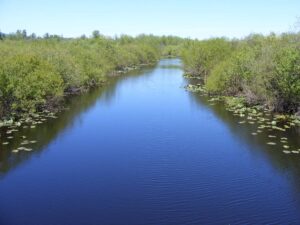A stable pH level is vital for healthy lake ecosystems. Moderately high pH provides the best productivity (for fish and other organisms) in both freshwater and marine habitats, but acids eliminate aquatic buffering by reducing alkalinity. Black Lake gets its name from humic (and other) acids that naturally occur from surrounding coniferous trees. As organic acids, they provide pH buffering which inorganic acids cannot offer.

Remember “acid rain” in the 70s that plagued northeastern North America? Scientists discovered that industrial emissions of sulfate and NOx (nitrate/nitrite) were creating acid precipitation. When such compounds reach water, they combine with hydrogen to form strong, corrosive acids – sulfuric and nitric acids.
Crystal clear lake water is convenient but not healthy
The lowering of pH in Blake Lake due to the application of aluminum sulfate (vs. algal blooms) is similar to past acid rain events by forming sulfuric acid. Strong acids mobilize (dissolve) heavy metals like aluminum, which are toxic to fishes. In an award-winning essay I wrote at Ohio Wesleyan University, I emphasized how acid precipitation causes waters to become overly clear. Such sterile conditions aren’t good for lake productivity, often causing fish kills from the combined effects of strong acids and aluminum, the latter of which clogs fish gills, leading to asphyxiation.
A healthy lake should have both plankton and aquatic macrophytes, in balance, at the base of the food chain. Phytoplankton feed zooplankton that feed young fishes. Likewise, aquatic macrophytes provide detritus and habitat cover for fish prey – benthic invertebrates that live at the bottom of a river or in its sediment. Ideally, native macrophytes are better than exotic plants for this, though the latter have unfortunately invaded Black Lake.
Integrated solutions can save Black Lake and protect aquifers, fish and plant life
Rather than continued use of alum for algal control, which would eventually cause the lake ecosystem to collapse, I suggest integrated-weed management for the future. This would include mechanical weed control (via rakes), simple glyphosate application for exotic weeks (using neither herbicides nor Roundup, proven to produce byproducts worse than glyphosate itself), and watershed management via stormwater control, cleaning/repair of leaky septic tanks, etc. Stormwater management often involves structural devices like filters that engineers build, but should also include riparian restoration. The latter should include upland conifers to help restore organic acids, as well as hardwood shrubs (e.g., willow and alder) near shore to help filter out pollutants – too many nutrients (e.g., lawn fertilization that is excessive or precedes rainstorms). High nutrients often benefit exotic plants, which lowers the availability of oxygen when they die, impacting lake salmonids.
The Black Lake Flood Control District has succeeded in reducing the exotic-weed and phytoplankton-bloom problems that once plagued the lake. Indeed, it looked like pea soup when I did a snorkeling-safety refresher course there in the fall of 2012. But native macrophytes actually help keep such overgrown algae at bay through shading, as do riparian trees, and provide good fish habitat and prey resources (as does large-woody debris).
In the future, adaptive management could better keep the lake’s water chemistry and plants in balance. Since BLFCD lacks the expertise to do so itself, I recommend that the flood-control district be suspended, if not dissolved, to improve lake-ecosystem management. Stormwater isn’t really a flood problem for Black Lake homes, but rather a land-use issue that brings nutrients into the lake to augment weeds and algae, especially toxic species that bother swimmers and dogs. And we must look beyond boating recreation if Black Lake is to remain valuable for multiple uses, including future fishing and safe well water for local residents.
Black Lake is the headwater for the Black River, which flows through Mima Mounds past Rochester into the Chehalis River, and on to Grays Harbor, which provides valuable fin and shellfishery resources for the Quinault Indian Nation and others. It is connected naturally to the Chehalis River and artificially to Percival Creek (and thus Capitol Like and Budd Inlet) through the Black Lake Ditch. Imperiled-aquatic vertebrates like Olympic mudminnows and Oregon spotted frogs grace the Black Lake/River watershed, and a white sturgeon was once found in the lake. Below the lake, Chinook and other native salmonids spawn and rear in the Black River, which provide critical prey for federally endangered Southern Resident orcas. Given the state’s efforts to restore fish habitat and migrations in the Chehalis Basin, it’s antiquated to treat Black Lake like an aquatic playground.
Bob Vadas, Jr. is a longtime aquatic ecologist and Olympia resident with a zoology/botany major and chemistry minor. References for assertions in this article are available at olywip.org. To learn more, visit:
Citizens for a Clean Black Lake
Save Black Lake Coalition
Chehalis Basin Strategy
| In March, Thurston County commissioners convened a public hearing on whether the Black Lake Flood Control Board should continue as the decision-making body for the lake’s ecosystem. Members of Citizens for a Clean Black Lake say water quality at Black Lake, which sits atop city wells in Olympia and Tumwater and is part of the Strategic Groundwater Reserve for the State Capitol, has degraded due to alum treatments and the annual use of toxic herbicides used to rid the lake of toxic-algal versus weed overgrowth. Over 40 public citizens spoke at the hearing, both in favor of and against dissolving the BLFCB.
Many of the testimonials referred to the December 2021 finding by a Federal court that the Washington Department of Ecology and the Environmental Protection Agency had failed to protect aquatic life in Washington State waters from toxins, in following outdated guidelines for protecting waterways which have declined in part by agency understaffing. No decision on the fate of the board has been made public by TC commissioners. |

Be First to Comment